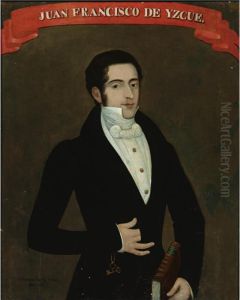Jose Gil De Castro Y Morales Paintings
Jose Gil de Castro y Morales, commonly known as Gil de Castro, was a notable painter of the independence era in South America. Born on November 20, 1785, in Lima, Peru, he was of Afro-Peruvian descent and is best recognized for his portraits of political leaders and heroes of the South American independence movements.
Gil de Castro's artistic journey began in his youth, but the details of his early training remain unclear. It is believed that he may have been self-taught or apprenticed to local artists in Lima. His talent soon garnered attention, and by the early 19th century, he had established himself as a portraitist of the colonial elite in Lima.
The political upheavals of the era deeply influenced his work. As the independence movements gained momentum across Latin America, Gil de Castro found himself at the center of the historical transformations. His portraits of key figures like Simon Bolivar, José de San Martín, and Bernardo O'Higgins are among his most famous works, capturing the likeness and spirit of those who were shaping the continent's future.
In the 1810s, Gil de Castro moved to Santiago, Chile, where his reputation continued to grow. He became the most sought-after portraitist among the newly independent ruling class. His style was characterized by detailed attention to the attire and decorations of his subjects, reflecting their social status and political significance.
After a successful period in Chile, he spent time in Buenos Aires, Argentina, and continued to paint portraits of important political figures. By the 1820s, he returned to Lima, where his work began to reflect a shift in style, possibly influenced by European neoclassicism. This later period is marked by a refined use of color and a more sober approach to his subjects.
Gil de Castro's legacy extends beyond his portraits. He also painted religious imagery and allegorical works, although these are less known. Throughout his career, he documented an era of profound change and left an indelible mark on the visual culture of South American independence.
He passed away on November 26, 1841, in Lima, leaving behind a rich body of work that provides invaluable insight into the historical and cultural context of early 19th-century South America. Today, Gil de Castro is celebrated not only for his artistic skill but also for his role as a chronicler of a transformative period in the continent's history.
